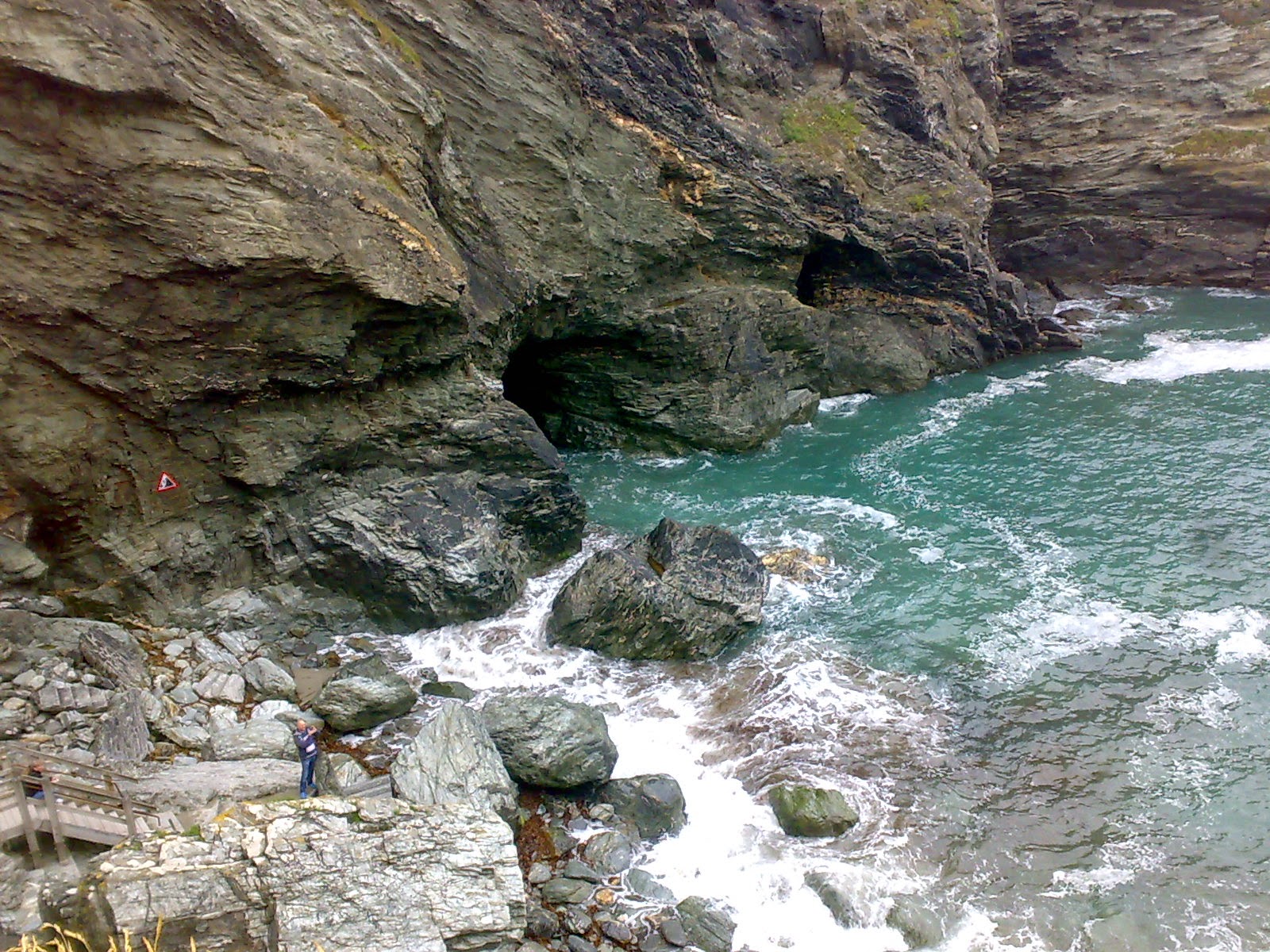Till last, a ninth one, gathering half the deep
And full of voices, slowly rose and plunged
Roaring, and all the wave was in a flame:
And down the wave and in the flame was borne
A naked babe, and rode to Merlin's feet,
Who stoopt and caught the babe, and cried "The King!
Here is an heir for Uther!"
Island of Disenchantment
Straddled across the windswept precipitous headland, Tintagel Castle is half on the mainland, half on the island, connected only by a narrow neck of land which has led to the popular acceptance that the origin of the name arises from Cornish Dintagel; 'Dun' meaning 'fort' with '-tagell' meaning 'narrow place'.
Suggestions that the source of the name is from 13th century Norman French at first glance seem absurd but Geoffrey of Monmouth's History of the Kings of Britain (Historia Regum Brittaniae) c.1136 AD contains the earliest written mention of Tintagel in the tale of how Arthur was conceived there when Uther Pendragon, King of Britain, magically assisted by Merlin of course, seduced Queen Igerna, the wife of Duke Gorlois of Cornwall. We have no idea why Geoffrey would have chosen Tintagel as the site of the conception but we do know that he placed much of his Arthurian 'history' in Cornwall.
 |
| So many steps.... |
This remained the accepted interpretation of Tintagel island until Archaeological excavations, commissioned by English Heritage, between 1990 and 1999 re-evaluated Radford's work and concluded that instead of a small community of Celtic monks, Tintagel may have been one of Western Britain’s premier centres of Dark Age political and military power.
 |
| Remains of the 13th century castle |
The pottery finds, combined with the buildings on the headland suggest intensive occupation at this period, often interpreted as a seasonal stronghold of the Kings of Dumnonia (Devon and Cornwall).
The high-quality Mediterranean pottery has also been found at Cadbury Castle in Somerset, a favoured suggestion for Arthur's Camelot. Then suddenly the pottery imports stopped.
 |
| Dark Age remains near the summit |
In about 1480 the antiquary William Worcestre claimed Tintagel as the place of Arthur’s birth as well as his conception but the identification of Tintagel as King Arthur’s Castle is not found until 1650. However, by now Arthur's base was firmly established at Camelot, wherever that was, and Tintagel,with little activity, slipped into relative obscurity until a late revival in the Victorian Age and became a tourist attraction.
 |
| Merlin's Cave |
Today the site is managed by English Heritage and many visitors, myself included, come away with a rather negative picture of the place of where King Arthur was conceived, or born, depending which legend you are recalling. The dominant remains are those built by Richard, Earl of Cornwall, in the 13th century. The Dark Age remains are slight and, as well laid out and identified as they are, are not much to look at and hardly inspire any connections to a 6th century power base of the Kings of Dumnonia. The so-called 'Artognou' stone found on the headland in 1998 has no connection whatsoever with King Arthur although it was much publicised as such at the time of its discovery; no doubt it was good for business. Even the name of the island may be French. And to cap it all the video display shown in the EH visitor centre will certainly dispel any hopes of finding an historical Arthur here. I left this island of disappointments feeling rather flat like so many others.
On walking back up to the village, once named Trevana, but not shy in missing the opportunity of Arthurian exploitation, they changed its name to Tintagel to match the castle, you pass the King Arthur's Arms Inn and opposite is the oldest Post Office in the country, dating to the 14th century, complete with sagging roof. Further along the high street passing a myriad of gift shops you arrive at King Arthur's Great Halls of Chivalry.
Copyright © 2015 Edward Watson
http://clasmerdin.blogspot.co.uk/
Sources:
Alfred, Lord Tennyson, The Coming of Arthur from Idylls of the King
Paul Broadhurst, Tintagel and the Arthurian Mythos, Pendragon Press, 1992.
Colleen E Batey, Tintagel Castle, English Heritage Guidebooks, 2010.
Oliver Padel, Cornish Place-name Elements, Nottingham: English Place-Name Society, 1985.
All photographs copyright © 2015 Edward Watson
* * *



No comments:
Post a Comment
Note: only a member of this blog may post a comment.